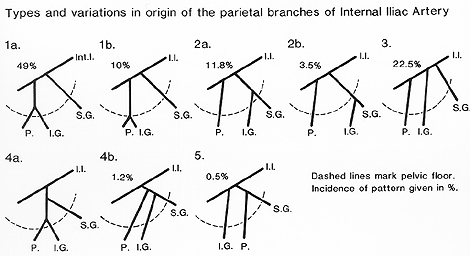

Illustrated Encyclopedia of Human Anatomic Variation: Opus II: Cardiovascular System
Ronald A. Bergman, PhD
Adel K. Afifi, MD, MS
Ryosuke Miyauchi, MD
Peer Review Status: Internally Peer Reviewed

Int. I. or I.I.= internal iliac artery; I.G.= inferior gluteal artery; P.= pudendial artery; S.G.= superior gluteal artery.
Type 1: The superior gluteal artery arises separately from the internal iliac artery, and the inferior gluteal and the internal pudendal artery arise from a common trunk. If the latter divides within the pelvis it is considered to be type la, whereas if the bifurcation occurs below the pelvic floor it is classified as type lb.
Type 2:The superior and inferior gluteal arteries arise by a common trunk and the internal pudendal vessel separately. In this category, as in the previous one, two subtypes are described. Type 2a includes those specimens in which the trunk common to the two gluteal arteries divides within the pelvis, and Type 2b those in which the division occurs outside the pelvis.
Type 3: The three branches arise separately from the internal iliac artery.
Type 4:The three arteries arise by a common trunk. The subtyping in this group is based on the sites of origin of the superior gluteal and the internal pudendal arteries from the parent stem. In Type 4a the trunk first gives rise to the superior gluteal artery before bifurcating into the other two branches; in Type 4b the internal pudendal is the first vessel to spring from the common trunk, which then divides into superior and inferior gluteal arteries.
Type 5: The internal pudendal and the superior gluteal arteries arise from a common trunk, and the inferior gluteal has a separate origin.
Braithwaite provides the following summary:
1. The sites of origin of the superior gluteal, inferior gluteal, internal pudendal, and obturator arteries have been investigated in 169 specimens (108 males and 61 females).
2. The superior gluteal, inferior gluteal, and internal pudendal arteries are comparatively constant in their origins.
3. The obturator artery is more variable and arises as a direct branch from the anterior division of the internal iliac artery in 41.4% of instances, from the inferior epigastric artery in 19.5%, from the superior gluteal in 10%, from the inferior gluteal-internal pudendal trunk in 10%, and a double origin in 6.4%. In only 23% of instances is a similar origin noted on both sides.
from Braithwaite, J.L. (1952) Variations in origin of the parietal branches of the internal iliac artery. J. Anat. 86:423-430.
Section Top | Title Page
Please send us comments by filling out our Comment Form.
All contents copyright © 1995-2025 the Author(s) and Michael P. D'Alessandro, M.D. All rights reserved.
"Anatomy Atlases", the Anatomy Atlases logo, and "A digital library of anatomy information" are all Trademarks of Michael P. D'Alessandro, M.D.
Anatomy Atlases is funded in whole by Michael P. D'Alessandro, M.D. Advertising is not accepted.
Your personal information remains confidential and is not sold, leased, or given to any third party be they reliable or not.
The information contained in Anatomy Atlases is not a substitute for the medical care and advice of your physician. There may be variations in treatment that your physician may recommend based on individual facts and circumstances.
URL: http://www.anatomyatlases.org/